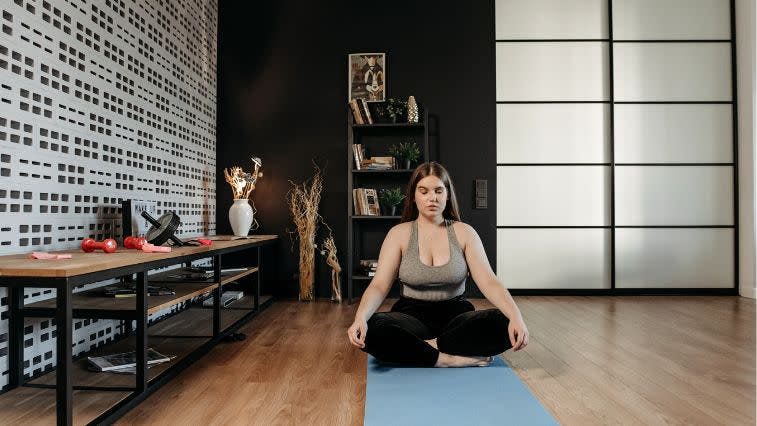Building Muscle While Losing Fat Is Possible, With These CPT- and Science-Backed Strategies
Our content strives to support, inform, and motivate you to meet your health goals. We want to be your trusted source of expert- and science-backed info dispensed in simple, actionable ways. Read our Editorial Guidelines.
As a personal trainer, the most popular goal I hear from clients is they want to lose fat and build muscle at the same time.
There are a lot of conflicting messages, fads, and false promises circulating online and in gyms about the best way to achieve this elusive body composition goal. There are even people who will tell you it can’t be done. While separate phases of targeted muscle building and fat loss can get you more dramatic results, there are certainly ways to support both goals at once.
After several years of training experience, multiple certifications, and hundreds of hours researching what the science says, I have specific advice for these clients. I tell them to tune out the fad fitness trends and try research-supported exercise strategies to accelerate fat burning while also training in a way that helps them build muscle. I’ll show you how.
Who Should Try Losing Fat and Building Muscle at the Same Time?
Losing fat and building muscle at once is often referred to as body recomposition. People with this goal seek ways to eat and train to support losing fat while adding lean muscle mass. The problem is these goals typically have very different strategies for how much to eat and how to work out to make each happen.
Seasoned gym goers and bodybuilders use specific “bulking” and “cutting” phases to either increase their muscle (bulk) or decrease their body fat levels (cut). While keeping these goals separate works very well for people who’ve been training for a long time or who plan to compete, many people can benefit from body recomposition strategies to reshape their bodies.
The main types of people who can work on these two goals at once include:
Anyone new to dieting and lifting weights
Those who have a lot of body fat
People who’ve taken a long break from training
Trained individuals who haven’t ever pushed themselves to build muscle
If you fit into one of these categories, you will likely see fantastic results from body recomposition strategies. If you’ve been resistance training for a long time and have a lot of muscle mass, you might not see as much progress. Separate phases should work better for you.
Let’s get into the strategies that work for body recomposition.
Move Your Body More Throughout the Day

My clients are always surprised when I tell them the most crucial movement they can do to support fat loss and muscle gain is outside of the gym. Most of your energy expenditure throughout the day comes from non-exercise activity (NEAT). Even if you work out regularly, if the rest of your time is spent sedentary, losing fat will be hard.
Non-exercise activity is everything from fidgeting to washing dishes to walking around your workplace or home. The energy you use doing various activities throughout the day adds up to more energy burned than you do through exercise in most cases. Research backs this up. When my clients have trouble with weight loss despite working out consistently, a sedentary lifestyle outside of training is usually the culprit.
Here’s what to do: Add more steps to your day. Try tracking your steps with your phone or fitness tracking device. Wherever you are now, simply add 1,000 or more steps to your day each week to see results. Build movement into your day naturally with walks, household chores, activity breaks from your desk, folding laundry, walking in place while watching TV, or pacing while on your phone. It all adds up.
Prioritize Resistance Training
Resistance training by lifting weights or using your body weight is the most powerful tool in your toolbox for gaining muscle. Your muscles need coaxing to grow; to achieve this, you need to challenge them with more intense work than they already do.
To keep building muscle, you must keep increasing the challenge, getting stronger, and lifting more over time. This can mean adding more reps, sets, training sessions, and weight. This type of exercise is called hypertrophy training — hypertrophy means muscle growth. Focusing on this type of training is essential for the best results.
Common mistakes I see people make to lose weight with resistance training is to add circuit training, reduce rest times, or add high-intensity movements like plyometrics between sets. Circuit training is a style of training that consists of moving from one exercise to another without taking a rest. Some people believe that not resting will keep your heart rate up, leading to more calories burned while still building muscle. Shortening rest is another popular strategy to keep the heart rate up in an attempt to burn more calories.
Unfortunately, this isn’t the best choice. When you focus primarily on keeping your heart rate up and don’t rest, you won’t be able to challenge your muscles enough to encourage growth. Your muscles won’t recover enough to work hard in the next set or exercise, and you will be less likely to build muscle.
While it’s true that increasing calorie burn will encourage fat loss, it will not help you build muscle, and you won’t be able to burn enough calories to truly make much of a difference in your daily energy expenditure this way. In fact, it could be more of a waste of your time in the gym than anything else.
Here’s what to do: Focus on well-designed resistance training sessions three times per week or more, depending on your fitness level. You should work each muscle group at least twice per week to see results and ensure you’re continuously progressing your weights, volume, and intensity. A personal trainer can help you set up a training plan that adapts over time to keep you building muscle and seeing results.
Add Cardio When You Need to

Cardio is incredibly beneficial for your overall health and wellness. But, many think cardio training is the ultimate way to burn fat. It surprises my clients when I tell them that resistance training counts as cardio, and so do their daily walks, housework, and other activities that increase their heart rates.
Trying to do high-intensity interval training (HIIT) or other forms of intense cardio very often is not ideal for fat loss and muscle building. While HIIT and steady-state, longer cardio sessions will help you burn calories and improve your health, they will not burn enough calories to be the primary way you will achieve fat loss.
Performing too much high-intensity cardio can impede muscle-building and overall energy expenditure because HIIT and long daily cardio sessions are tough to recover from. Your body will adapt to this activity by slowing down your metabolism and other physiological factors that will adjust to protect you from losing so much energy.
To lose fat, you will need a slight calorie deficit (eating less than you burn). When you are in an energy deficit, doing too much intense cardio can lead to overtraining, exhaustion, and injury.
Here’s what to do: Add some additional gentle cardio when you feel your fat loss efforts need a bit of a push. Focus on adding more walking and less intense forms of cardio instead so you can bring your A-game to your resistance training sessions. You can also do one to two HIIT sessions each week that are 15 to 20 minutes long, so long as you’re recovering well and feel energized throughout the week.
Factor in Rest and Recovery

Finally, it’s vital to factor in rest and recovery. Many of my clients believe that the answer to achieving their fat loss goal is to keep adding more and more intense activity and training sessions. My number-one advice to these people, especially if they’re starting to see their progress slow down or plateau, is to add more rest and recovery.
While this may seem contradictory, it’s essential to realize that your metabolism will adapt to your efforts to lose fat by slowing down some processes and adjusting your hormone levels, including those that encourage you to feel hungry and eat more. Sometimes, what people need the most is to allow their bodies time to recover and regain energy and strength to keep their training and diet on track.
Moreover, recovery and active rest such as walking, hiking, gentle swimming, yoga, stretching, meditation, and self-care practices on off days help reduce the stress hormones that can get in the way of your progress.
What Else You Should Consider for Fat Loss and Muscle Building
While these strategies are highly effective for building muscle while losing fat, they won’t work well without other lifestyle factors. My clients see the best results when they ensure their diet supports a slight energy deficit (eating fewer calories than they burn) that is not too big.
Slow and steady fat loss is best if you want to also build muscle since building new tissue requires lots of calories, protein, and nutrients. Cutting a lot of calories and losing weight quickly is very unlikely to help you build muscle. In fact, you could lose muscle this way.
Sleep and stress are other critical factors, so getting in your rest days and active recovery and ensuring you have a solid bedtime routine and enough sleep is best if you want to benefit from body recomposition strategies.
Lastly, don’t forget to track your progress and celebrate your successes, no matter how small. Reshaping your body for long-term health and physique improvements is no easy task, but doing it correctly will set you up for sustainable, long-term results.
Feeling overwhelmed? An expert can help! Get a free consultation with a certified personal trainer to learn how they can help you reach your body composition goals.